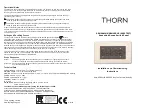
IMT117-06
www.ueonline.com
IMT117-06
www.ueonline.com
117 Series
Temperature Switch
Types B117, E117
U N I T E D E L E C T R I C
C O N T R O L S
Installation and Maintenance
Instructions
IMT117-06
GENERAL
MISUSE OF THIS PRODUCT MAY CAUSE EXPLOSION AND PERSONAL
INJURY. THESE INSTRUCTIONS MUST BE THOROUGHLY READ AND
UNDERSTOOD BEFORE UNIT IS INSTALLED.
THIS EQUIPMENT IS SUITABLE FOR CLASS I, DIVISION 2,
GROUPS A,B,C,D; CLASS II, DIVISION 2, GROUPS F AND G; CLASS III;
OR NON-HAZARDOUS LOCATIONS ONLY.
Types B117 (Immersion Stem)
The 117 Series temperature switch utilizes a liquid filled sensor which
expands or contracts against a bellows to detect a temperature change.
The response, at a pre-determined set point, actuates or deactuates a
SPDT or DPDT snap-acting switch, converting the temperature signal into an
electrical signal. Control set point is adjusted by turning an internal dial (see
adjustment - Part II).
Types E117 (Bulb & Capillary)
The 117 Series temperature switch utilizes a liquid-filled sensing bulb which
hydraulically transmits temperature change to a bellows. The response, at
a pre-determined set point, actuates or deactuates a SPDT or DPDT snap-
acting switch, converting the temperature signal into an electrical signal.
Control set point is adjusted by turning an internal dial (see adjustment
- Part II).
MAXIMUM TEMPERATURE: THE HIGHEST TEMPERATURE TO WHICH
A SENSING ELEMENT MAY BE OCCASIONALLY EXPOSED TO WITH-
OUT ADVERSELY AFFECTING SET POINT CALIBRATION AND REPEAT-
ABILITY. MAXIMUM TEMPERATURE STATED IN LITERATURE AND ON
NAMEPLATE MUST NEVER BE EXCEEDED, EVEN BY TEMPERATURE OVER-
SHOOTS IN THE SYSTEM. OCCASIONAL OPERATION OF UNIT UP TO MAX.
TEMPERATURE IS ACCEPTABLE (E.G., START-UP, TESTING). CONTINUOUS
OPERATION SHOULD BE RESTRICTED TO THE DESIGNATED ADJUSTABLE
RANGE.
THESE PRODUCTS DO NOT HAVE ANY FIELD REPLACEABLE PARTS.
ANY SUBSTITUTION OF COMPONENTS MAY IMPAIR SUITABILITY FOR
CLASS I, DIVISION 2
Part I - Installation
Tools Needed
Adjustable Wrench
Screwdriver
Hammer (for alternate wire knockouts)
MOUNTING
WARNING: EXPLOSION HAZARD - DO NOT DISCONNECT EQUIPMENT
UNLESS POWER HAS BEEN SWITCHED OFF OR THE AREA IS KNOWN
TO BE NON-HAZARDOUS.
INSTALL UNIT WHERE SHOCK, VIBRATION AND TEMPERATURE
FLUCTUATIONS ARE MINIMAL. MOUNT UNIT SO THAT MOISTURE IS
PREVENTED FROM ENTERING THE ENCLOSURE. IF UNIT IS BEING
INSTALLED WHERE HEAVY CONDENSATION IS EXPECTED, VERTICAL
MOUNTING (TEMPERATURE SENSOR DOWN) IS REQUIRED. DO NOT MOUNT
UNIT IN AMBIENT TEMPERATURES EXCEEDING PUBLISHED LIMITS.
ALWAYS HOLD A WRENCH ON THE TEMPERATURE HOUSING HEX
WHEN MOUNTING UNIT. DO NOT TIGHTEN BY TURNING ENCLOSURE.
THIS WILL DAMAGE SENSOR AND WEAKEN SOLDERED OR WELDED
JOINTS.
117 Series Temperature Controls can be mounted in any position. Mount the
unit via the (2) 1/4” screw clearance holes on the enclosure (see Mounting
Dimensions).
Please read all instructional literature carefully and thoroughly before starting. Refer to the final page for the listing of Recommended
Practices, Liabilities and Warranties.
For remote mounting, fully immerse the bulb and 6” capillary in the control
zone. For best control, it is generally desirable to place the bulb close to the
heating or cooling source in order to sense temperature fluctuations quickly.
Be sure to locate the bulb so it will not be exposed to temperature beyond
the instrument range limits.
WIRING
DISCONNECT ALL SUPPLY CIRCUITS BEFORE WIRING UNIT.
WIRE UNITS ACCORDING TO NATIONAL AND LOCAL ELECTRI-
CAL CODES. MAXIMUM RECOMMENDED WIRE SIZE IS 14 AWG.
THE RECOMMENDED TIGHTENING TORQUE FOR FIELD WIRING
TERMINALS IS 7 TO 17 IN-LBS.
ELECTRICAL RATINGS STATED IN LITERATURE AND ON NAMEPLATE
SHOULD NEVER BE EXCEEDED. OVERLOAD ON A SWITCH CAN
CAUSE FAILURE ON THE FIRST CYCLE.
Remove the two screws retaining the cover and cover gasket. A 1/2” NPT
conduit connection is provided on the left hand side of the enclosure. Two
cast-in 7/8” diameter knock outs for electrical conduits are located on the
side and back of enclosure (see dimensional drawings, opposite page).
These can easily be knocked out by placing a blade of a screwdriver in
groove and tapping sharply with a hammer. The terminal block terminals are
clearly labeled “Common”, “Normally Open” and “Normally Closed.” For units
supplied with DPDT, all terminals are labeled and the following color coding
applies.
Grounding screw and clamp (cast in symbol) are provided. Keep the wire as
short as possible to prevent interference with the plunger.
Part II - Adjustments
To change set point, turn dial and align with pointer.
Types B117 and E117
with dial knob controls are factory calibrated for
maximum accuracy at the midpoint of the scale.
Re-calibration
To re-calibrate, turn dial to desired set point. If the actual temperature and set point
temperature do not agree, turn the 3/16” hex fine adjustment screw to the left to
raise and to the right to lower temperature setting.
SPDT
DPDT
SWT1
SWT2
Common
Violet
Violet
Yellow
Normally Closed Black
Black
Red
Normally Open
Blue
Blue
Orange




















